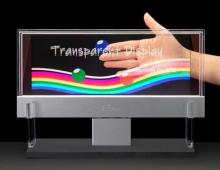
Japan Display Develops 5-inch Full-HD TFT LCD Module with Touch Functionality
Japan Display has developed a 5.0-inch Full-HD (1,080 x
1,920 pixels) TFT LCD module with JDI's proprietary
integrated touch functionality "Pixel Eyes".
JDI started mass production of a 5.0-inch Full-HD TFT LCD
module in October 2012, and introduced an R&D prototype of
the 5.0-inch Full-HD "Pixel Eyes" version in the same month
as part of JDI's "Innovation Vehicle" lineup shown at the
FPD International 2012 exhibition in Yokohama, Japan. JDI
has now succeeded in establishing "Pixel Eyes" and its touch
function controller on a production-ready basis for a new
5.0-inch Full-HD TFT LCD module.
 There are various requirements for LCD module
performance in the market today, such as higher resolution,
wider viewing angle, higher picture quality, lower power
consumption, and thinner module thickness. In addition,
higher productivity of touch-based devices. According to
JDI, "Pixel Eyes" contributes to high productivity because
the touch functionality is formed with fewer process steps
compared to conventional touch choices.
There are various requirements for LCD module
performance in the market today, such as higher resolution,
wider viewing angle, higher picture quality, lower power
consumption, and thinner module thickness. In addition,
higher productivity of touch-based devices. According to
JDI, "Pixel Eyes" contributes to high productivity because
the touch functionality is formed with fewer process steps
compared to conventional touch choices.
"Pixel Eyes" detects touch through changes in capacitance between electrodes on the TFT substrate and on the color filter substrate.
JDI has a "Pixel Eyes" product lineup in mass production, available in resolution formats of 720HD (720 x 1280 pixels) and qHD (540 x 960 pixels).
JDI's touch controller drive system realizes a high signal-to-noise (S/N) ratio under various operating environments to ensure touch usability. The JDI system configuration synchronizes the LCD driver and the touch controller, and detects the touch event during a period in time outside of the display RGB write period. This realizes a high S/N ratio under various operating environments to ensure touch usability, and also holds promise for other user interfaces, such as input by a passive stylus.
The integration of the touch functionality into the LCD eliminates the need for an external touch panel. The configuration reduces module thickness by approximately 30% versus conventional modules with external touch panels, and by approximately 10% versus recently popular modules which adopt a touch sensor function on the cover lens.
"Pixel Eyes" does not require an external touch panel, and therefore reduces optical reflections at the component surface boundary interfaces and improves visibility. For the same reason, transmittance is increased by approximately 10% compared to conventional modules with external touch panels, contributing to an increase in module brightness.
"Pixel Eyes" requires only one additional process step to add the touch functionality, though other touch methods typically require multiple process steps. JDI is planning to start mass production of "Pixel Eyes" products at the new G6 production line in Mobara, Japan, that goes into operation in June 2013.
Specifications
- Screen size: 5.0-inch (12.6cm) (diagonal)
- Number of pixels: 1,080 (x RGB) x 1,920 (Full-HD)
- Resolution density: 445ppi
- Display mode: Transmissive IPS
- Viewing angle: Vertical/Horizontal 160 degrees (with contrast ratio > 100:1)
- Dimensions: 63.6mm (width) x 115.8mm (height)
- Surface luminance: 450cd/m2 (Typ.)
- NTSC ratio: 71%
Contrast ratio: 1000:1 (Typ.)
"Pixel Eyes" detects touch through changes in capacitance between electrodes on the TFT substrate and on the color filter substrate.
JDI has a "Pixel Eyes" product lineup in mass production, available in resolution formats of 720HD (720 x 1280 pixels) and qHD (540 x 960 pixels).
JDI's touch controller drive system realizes a high signal-to-noise (S/N) ratio under various operating environments to ensure touch usability. The JDI system configuration synchronizes the LCD driver and the touch controller, and detects the touch event during a period in time outside of the display RGB write period. This realizes a high S/N ratio under various operating environments to ensure touch usability, and also holds promise for other user interfaces, such as input by a passive stylus.
The integration of the touch functionality into the LCD eliminates the need for an external touch panel. The configuration reduces module thickness by approximately 30% versus conventional modules with external touch panels, and by approximately 10% versus recently popular modules which adopt a touch sensor function on the cover lens.
"Pixel Eyes" does not require an external touch panel, and therefore reduces optical reflections at the component surface boundary interfaces and improves visibility. For the same reason, transmittance is increased by approximately 10% compared to conventional modules with external touch panels, contributing to an increase in module brightness.
"Pixel Eyes" requires only one additional process step to add the touch functionality, though other touch methods typically require multiple process steps. JDI is planning to start mass production of "Pixel Eyes" products at the new G6 production line in Mobara, Japan, that goes into operation in June 2013.
Specifications
- Screen size: 5.0-inch (12.6cm) (diagonal)
- Number of pixels: 1,080 (x RGB) x 1,920 (Full-HD)
- Resolution density: 445ppi
- Display mode: Transmissive IPS
- Viewing angle: Vertical/Horizontal 160 degrees (with contrast ratio > 100:1)
- Dimensions: 63.6mm (width) x 115.8mm (height)
- Surface luminance: 450cd/m2 (Typ.)
- NTSC ratio: 71%
Contrast ratio: 1000:1 (Typ.)




















